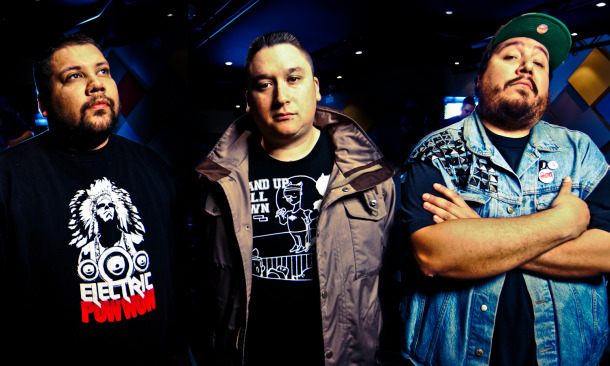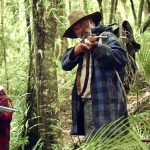by Kodi Alvord (Diné)
“We are the tribe that they cannot see.”
These powerful words from American Indian Movement activist John Trudell open A Tribe Called Red’s (ATCR) newest album, “We Are the Halluci Nation,” a musical manifesto of Native resistance expressed through pan-Indigenous collaboration and solidarity. The album reads as one flowing narrative of genocide, colonialism, survival, empowerment, and activism by Indigenous peoples.
ATCR is a three-man First Nations DJ collective made up of members Ian “DJ NDN” Campeau (Nipissing), Tim “2oolman” Hill (Mohawk), and Bear Witness (Cayuga). The collective formally began their music career together in 2012 with the free digital release of their first album, “A Tribe Called Red.” Since then, ATCR has become a party favorite for American Indian and First Nations youth, as their music blends traditional powwow music with contemporary electronic moombahton, dubstep, and hip-hop to produce what many have coined “powwow step.”
While “Halluci Nation” builds on the enormous success of ATCR’s former albums, powwow step is no longer an experiment in cross cultural musical synthesis, but a pointed political statement that enables its listeners to engage with contemporary Indigenous issues through music.
The album’s opening track, “We Are the Halluci Nation,” references the demonization and erasure of Native peoples. Above an electronic musical beat and melody, Trudell’s voice declares, “We have been called the Indians…Native Americans…Pagan…Hostile…Militant…. We have been called many names. We are the Halluci Nation. We are the Human Beings.” The term “Halluci Nation” encapsulates histories of fetishism, exploitation, and erasure from American popular awareness. To live as an Indigenous person today is to exist on the fringes of media, art, and national politics; essentially, to live as society’s hallucination. “We Are the Halluci Nation” combats this phenomenon.
Trudell’s poetry brackets the album, providing context for all the issues addressed by the music. The penultimate track, “ALie Nation,” contrasts with the opening track’s theme of self-determination by articulating a sense of loss and violation resulting from colonial destruction. The ALie Nation refers not to a set of people, but to the alienation of colonialism: alienation from community, family, culture, and land.
“Halluci Nation” could not have come at a better time. Thousands of indigenous people are currently resisting the construction of the Dakota Access Pipeline in North Dakota, as it threatens the destruction of Lakota land and water.
ATCR imbues “Halluci Nation” with emotional depth through two poetic vignettes in the tracks “BEFORE” and “SOON.” In “BEFORE,” a Native man named Jack calls from prison, begging the listener to find Charlie – a young boy who has run away from his residential boarding school. This call references a true story: in 1966 a 12-year-old First Nations boy named Charlie Wenjack escaped the Cecilia Jeffrey Indian Residential School and attempted to return home. His body was later found by nearby railroad tracks. In telling this story, ATCR confronts immediate, painful memories of forced assimilation in boarding schools. While American Indian boarding schools began to close in the mid 20th century, First Nations boarding schools in Canada lasted into the 1990’s. In “BEFORE,” Jack tells Charlie: “You’re still hurting…We hurt from The Before and it makes us hurt so bad right now,” making it clear that the historical colonial pain has not disappeared. It is present, raw, and persistent.
Jack calls again in “SOON” having accepted Charlie’s loss, offering a pained but optimistic outlook on the future. He declares, “Charlie didn’t need to die of exposure at the railroad tracks… but it’s his spirit that fills our Halluci Nation, light as helium but weighted by the drum.” The music stands as a testament to lives lost to colonial violence, and as a promise to build a better future for indigenous youth.
Although “Halluci Nation” describes lived experiences of alienation and violence, it also fights back with sharp lyrical delivery and meticulous melodic composition. In “R.E.D.,” Manawan powwow group Black Bear burns bright in dialogue with rapper Yasiin Bey’s lyrics. As Bey describes the colonial mindset, (“‘HUSH! That’s enough’ said the ruler”) Black Bear’s vocals rise up and overpower the moment. Black Bear recedes again until Bey declares, “Straightjacket come clean/ Big said it was a dream/ Now it’s a living thing/ We true and living kings,” at which point Black Bear’s vocals and ATCR’s electric melody rise together, propelling the song into the next verse.
“Halluci Nation” draws upon more pan-Indigenous collaboration and is more political in focus than ATCR’s previous works. The album moves across style and space to create a dynamic musical product. In addition to drum groups Black Bear and Northern Voice, “Halluci Nation” features Inuk throat singer Tanya Tagaq, Sami (an indigenous people from Northern Scandinavia and Russia) singer Maxida Märak, First Nations singer Jennifer Kreisberg, Colombian singer Lido Pimienta, and many more. The end result of this collaboration is a message: Indigenous people can and must work together to forge a better future.
Listen to “We Are the Halluci Nation” on Spotify here:



